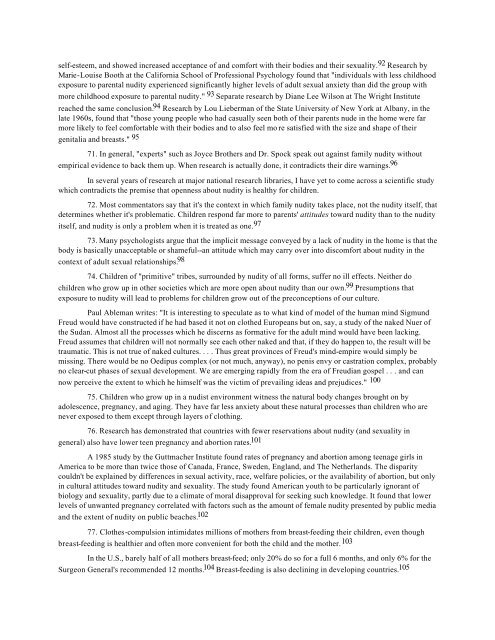Create successful ePaper yourself
Turn your PDF publications into a flip-book with our unique Google optimized e-Paper software.
self-esteem, and showed increased acceptance of and comfort with their bodies and their sexuality. 92 Research by<br />
Marie-Louise Booth at the California School of Professional Psychology found that "individuals with less childhood<br />
exposure to parental nudity experienced significantly higher levels of adult sexual anxiety than did the group with<br />
more childhood exposure to parental nudity." 93 Separate research by Diane Lee Wilson at The Wright Institute<br />
reached the same conclusion. 94 Research by Lou Lieberman of the State University of New York at Albany, in the<br />
late 1960s, found that "those young people who had casually seen both of their parents nude in the home were far<br />
more likely to feel comfortable with their bodies and to also feel mo re satisfied with the size and shape of their<br />
genitalia and breasts." 95<br />
71. In general, "experts" such as Joyce Brothers and Dr. Spock speak out against family nudity without<br />
empirical evidence to back them up. When research is actually done, it contradicts their dire warnings. 96<br />
In several years of research at major national research libraries, I have yet to come across a scientific study<br />
which contradicts the premise that openness about nudity is healthy for children.<br />
72. Most commentators say that it's the context in which family nudity takes place, not the nudity itself, that<br />
determines whether it's problematic. Children respond far more to parents' attitudes toward nudity than to the nudity<br />
itself, and nudity is only a problem when it is treated as one. 97<br />
73. Many psychologists argue that the implicit message conveyed by a lack of nudity in the home is that the<br />
body is basically unacceptable or shameful--an attitude which may carry over into discomfort about nudity in the<br />
context of adult sexual relationships. 98<br />
74. Children of "primitive" tribes, surrounded by nudity of all forms, suffer no ill effects. Neither do<br />
children who grow up in other societies which are more open about nudity than our own. 99 Presumptions that<br />
exposure to nudity will lead to problems for children grow out of the preconceptions of our culture.<br />
Paul Ableman writes: "It is interesting to speculate as to what kind of model of the human mind Sigmund<br />
Freud would have constructed if he had based it not on clothed Europeans but on, say, a study of the naked Nuer of<br />
the Sudan. Almost all the processes which he discerns as formative for the adult mind would have been lacking.<br />
Freud assumes that children will not normally see each other naked and that, if they do happen to, the result will be<br />
traumatic. This is not true of naked cultures. . . . Thus great provinces of Freud's mind-empire would simply be<br />
missing. There would be no Oedipus complex (or not much, anyway), no penis envy or castration complex, probably<br />
no clear-cut phases of sexual development. We are emerging rapidly from the era of Freudian gospel . . . and can<br />
now perceive the extent to which he himself was the victim of prevailing ideas and prejudices." 100<br />
75. Children who grow up in a nudist environment witness the natural body changes brought on by<br />
adolescence, pregnancy, and aging. They have far less anxiety about these natural processes than children who are<br />
never exposed to them except through layers of clothing.<br />
76. Research has demonstrated that countries with fewer reservations about nudity (and sexuality in<br />
general) also have lower teen pregnancy and abortion rates. 101<br />
A 1985 study by the Guttmacher Institute found rates of pregnancy and abortion among teenage girls in<br />
America to be more than twice those of Canada, France, Sweden, England, and The Netherlands. The disparity<br />
couldn't be explained by differences in sexual activity, race, welfare policies, or the availability of abortion, but only<br />
in cultural attitudes toward nudity and sexuality. The study found American youth to be particularly ignorant of<br />
biology and sexuality, partly due to a climate of moral disapproval for seeking such knowledge. It found that lower<br />
levels of unwanted pregnancy correlated with factors such as the amount of female nudity presented by public media<br />
and the extent of nudity on public beaches. 102<br />
77. Clothes-compulsion intimidates millions of mothers from breast-feeding their children, even though<br />
breast-feeding is healthier and often more convenient for both the child and the mother. 103<br />
In the U.S., barely half of all mothers breast-feed; only 20% do so for a full 6 months, and only 6% for the<br />
Surgeon General's recommended 12 months. 104 Breast-feeding is also declining in developing countries. 105


